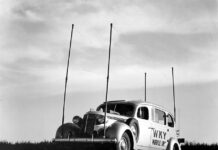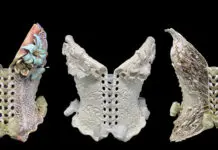Did you ever consider how tough it must be to come up with titles for songs that don’t have any words? While some great instrumentals are blessed with names that describe them perfectly – Santo & Johnny’s “Sleepwalk,” Link Wray’s “Rumble,” Leon McAuliffe’s “Steel Guitar Rag” and Count Basie’s “One O’Clock Jump,” for instance – many others are named for arcane references or obscure in-jokes and don’t really indicate musical content.
In his long and impressive career as a fiddle, mandolin and guitar player, Tulsa’s Shelby Eicher has written more than his share of instrumental numbers. He’s also good at coming up with titles that describe the sound.
Naming his new band, however, was a different story.
“When you name a group, it’s like writing a song,” he says. “Either you have the spark idea, and it flows right out, or you say, ‘Okay, I’ll keep working on it,’” he explains. “So we spent six months or so just hammering on it: ‘No, that sounds too cheesy. No, that one doesn’t work.’
“Then, I was talking to [fellow Tulsa fiddler] Rick Morton, and he said, ‘You’re so good at naming tunes; the name always sounds like what the music sounds like.’ I said, ‘Yeah. You know when I wrote that tune “Mischievous Swing,” I named it that because it just had a kind of mischievous sound.’
“He said, ‘That’s the name of your band right there.’ I said, ‘But that’s the name of a tune.’ He said, ‘That’s okay.’”
So Eicher returned to his bandmates – sons Isaac (mandolin) and Nathan (bass) along with their contemporary Ivan Pena (guitar) – and related what Morton had told him.
“They said, ‘Well, yeah,’” recalls Eicher with a chuckle. “So I’m not going to say we were named by default, but it took a long time to figure out that, ‘Hey, we already have this name, it’s really cool, and it’s what the group sounds like.’”
The fact that the term also conjures up, in some music lovers’ minds, images of the sly gypsy-jazz virtuosos Django Reinhardt and Stephane Grappelli and their revered ‘30s outfit, the Hot Club of France is also appropriate. One listen to Mischievous Swing’s new eponymously titled CD is all you need to hear the connection. As was the case with the music of guitarist Reinhardt and violinst Grappelli, this is high-energy string-band jazz and swing, complex and arresting, fiery and sure-handed. It’s the kind of sound that comes from people who have been playing together for years, taking off into different musical directions, exploring new horizons.
Eicher, who grew up in Ohio playing square dances and other events with his parents and grandmother, got to string jazz via bluegrass, with stops in-between for western swing and Dawg music, the musical fusion created in the ‘70s by mandolinist David Grisman and his quintet.
“They used bluegrass instruments – two mandolins, a fiddle, guitar and bass – but they had jazz sensibilities,” he says of Grisman’s group. “They fused gypsy music, Latin music, klezmer and really created something unique. Around 1978, I got turned onto [the Grisman album] Hot Dawg, That had some Stephane Grappelli on it and I thought, ‘Oh, my gosh. Whoever this is, he’s way above everyone else. That was my first exposure to him – and to jazz, really.”
Eicher ultimately went to work in Roy Clark’s band, a position he would hold for many years. But his love for jazz continued unabated.
“Even when I was with Roy, I’d go play with [legendary Tulsa jazz guitarist] Randy Crook,” he remembers. “And I was studying Charlie Parker, you know. I’d meet up with the guys in the band and they’d ask me, ‘What are you listening to?’” He laughs. “They’d be listening to the commercial music, which is fine, but it was like learning to make McDonald’s hamburgers. The other way, you’re trying to be like a gourmet French chef.
“I think it was just the jazz music itself that intrigued me,” he adds. “Of course, Janet sings jazz, you know, so we always had that kind of thing going on.”
“Janet” is the well-known area vocalist Janet Rutland, who’s been married to Eicher for many years. They are the parents of Nathan and Isaac and a third son, Paul, who plays guitar as a sideline while holding down a full-time job as an academic advisor at Tulsa Community College.
“The boys and I used to just play around the house, and every now and then, as they got older, we’d do some shows with Janet,” Eicher says. “Over the years, we had kids in football, in debate tournaments, and I was working full-time with [guitarist] Mark Bruner, so there really weren’t a lot of opportunities for us to work shows together. Then the kids went off to college and we started playing together less. It’d only be on a holiday or something, or two of us would play and the others wouldn’t be here.”
Then, bassist Nathan finished his education by getting a master’s degree in jazz from the University of Central Oklahoma, and Isaac, a national championship mandolin player, returned from a stint at a college in Spain, where, his father notes, “he really started focusing on people like the Rosenberg Trio, gypsy guys who play like Django.” Isaac also began playing regularly in Norman with guitarist Pena.
“After Isaac got back from Spain, we were kind of talking about this whole thing,” Eicher says. “Nathan’s really into jazz now, and we had a real focus, something that we really wanted to do. And we thought if we were going to do something gypsy-esque, maybe Ivan would like to do it.”
It turned out that he would indeed, and the members of Mischievous Swing began working together in earnest the last couple of months of 2012. Since then, the group has played a number of engagements, including a well-received appearance at the East Coast Django Gypsy Fest in Pennsylvania, and recorded the Mischievous Swing CD, which features one Isaac and four Shelby Eicher originals along with versions of jazz and swing classics ranging from “Honeysuckle Rose” to Dave Brubeck’s “Take Five” and Chick Corea’s “Spain.” A release party is planned for later in August at the Oklahoma Jazz Hall of Fame in Tulsa.
“I think the other influence we have besides swing and gypsy music and modern jazz, whatever that is, is Latin,” says Eicher. “Isaac’s tune, ‘Valencia,’ is somewhat Brazilian, and then we’ve done a bossa nova. And when you get to ‘Spain,’ that’s a samba rhythm. We really like the mixture of grooves.”
Although the players who make up Mischievous Swing are working musicians with other regular gigs – Shelby, for instance, continues his 17-year association with Mark Bruner in a trio with vocalist Annie Ellicott, along with leading the western-swing band the Tulsa Playboys – they can see the potential this act has to be something special. So can Roy Clark, to whom the group gave a private show in his Tulsa office.
“Roy called me the next day, and he was so excited,” Shelby says. “He said, ‘I was absolutely blown away. The musicianship and the music – I have no words to say how great it was.’ I thought that was a really nice compliment.
“I think our show’s exciting,” he concludes. “I think it’s fun to watch. And, you know, it’s always fun to play with your kids.”






















